Agapanthus Garden Ideas: Brighten Your Yard with Beautiful Blooms
Agapanthus, with its striking blue or white blooms, can turn any garden into a beautiful and serene space. Their elegant form and versatile nature make them a favorite among gardeners looking to add a touch of sophistication to their outdoor areas.
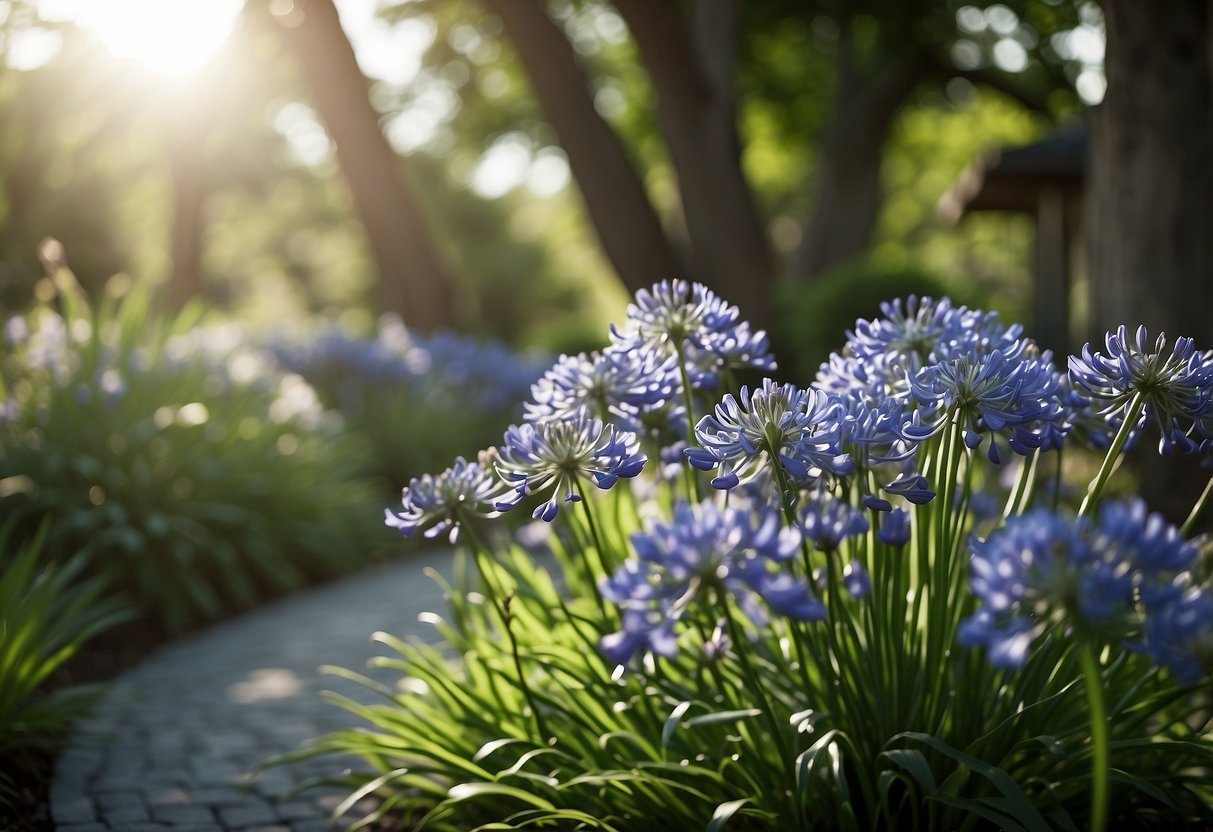
Whether you’re planning a full garden makeover or just looking to spruce up a small corner, these flowers offer endless possibilities. From cottage-style gardens to modern landscapes, agapanthus can complement various garden designs effortlessly. Dive into the following ideas and let your creativity blossom.
1) Plant Agapanthus ‘Africanus’

Agapanthus ‘Africanus’ is a great plant for adding color to your garden. These plants have beautiful blue flowers that bloom in early to mid-summer.
Choose a sunny spot in your garden with well-draining soil. Dig a hole about 2 inches deep and place the rhizomes with the pointed ends facing up.
Water the plant regularly, especially during dry spells. Agapanthus ‘Africanus’ thrives with organic compost worked into the soil. For more planting tips, check out this guide on growing agapanthus.
2) Use Agapanthus ‘Albus’ for White Gardens

Agapanthus ‘Albus’ brings elegance to any white-themed garden. This variety blooms with crisp, snow-white, trumpet-shaped flowers that stand out beautifully against the green foliage.
The flowers are perfect for creating a serene and calming atmosphere in your garden.
Consider planting them along pathways or in flower borders to enhance the visual appeal. They also pair well with other white-blooming plants for a cohesive look.
3) Decorate Pathways with Agapanthus ‘Blue Heaven’
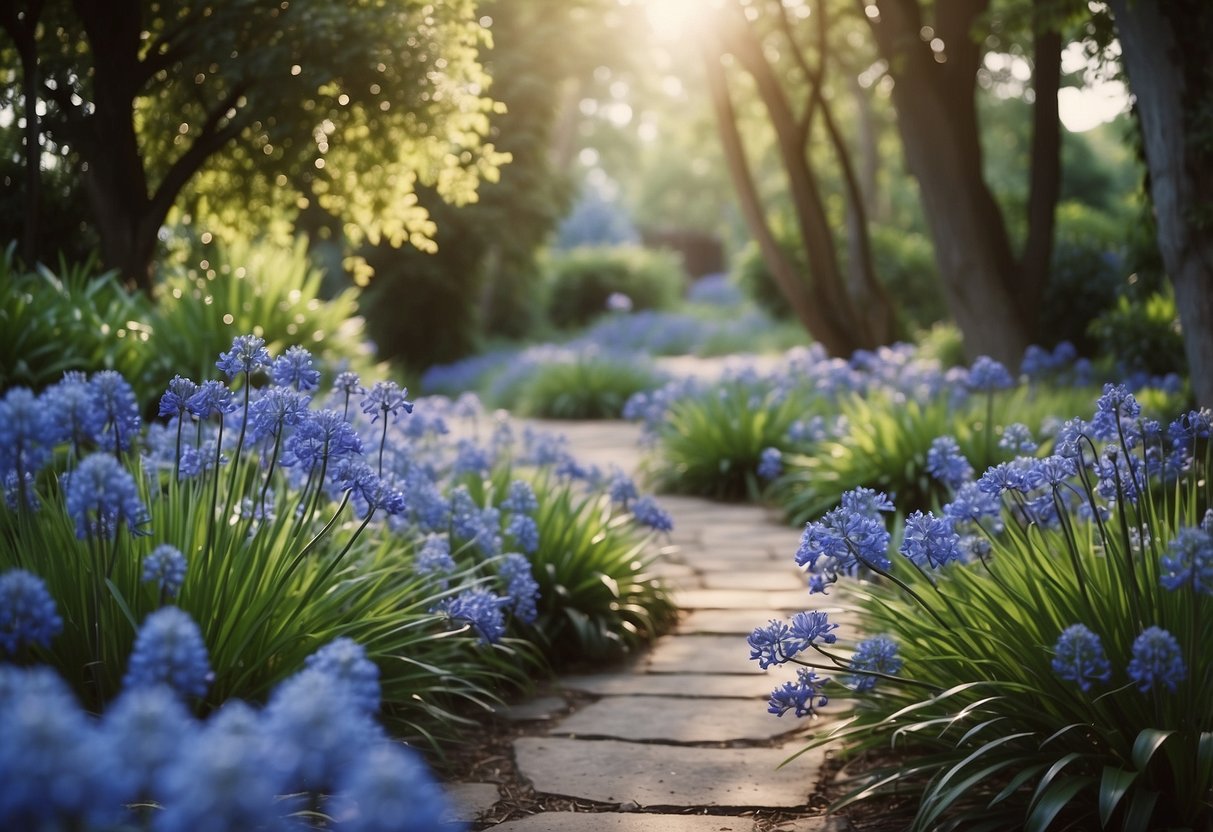
Agapanthus ‘Blue Heaven’ has striking blue flowers that create a beautiful border along garden paths.
These tall, elegant plants will guide visitors with their vibrant hues.
For the best results, plant them in full sun and well-drained soil.
Their blooms will last all summer, giving your garden a continuous splash of color.
Use ‘Blue Heaven’ to make every stroll through your garden a delight.
Consider adding lavender nearby, as it complements the agapanthus nicely.
4) Mix Agapanthus ‘Donau’ with Lavender
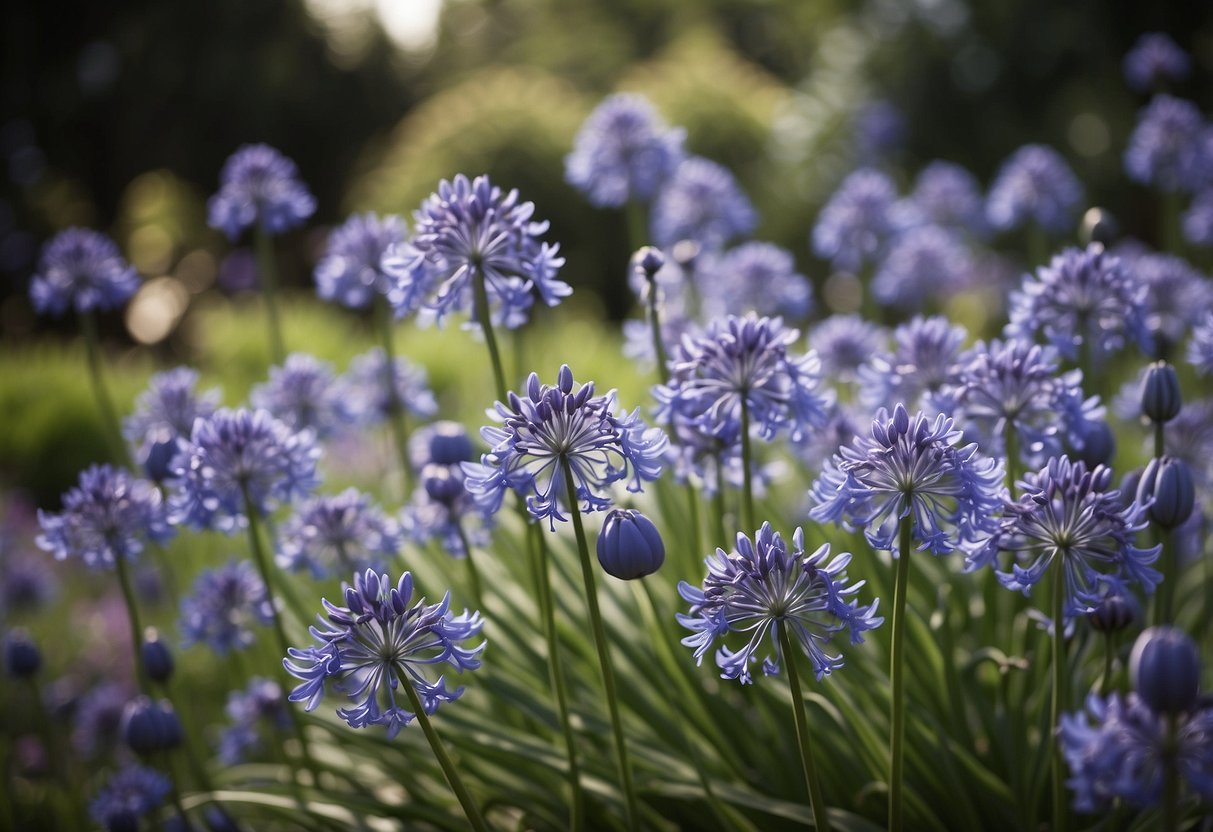
You can create a charming garden by mixing Agapanthus ‘Donau’ with lavender. The striking blue flowers of Agapanthus ‘Donau’ pair beautifully with lavender’s purple blooms.
Both plants love full sun and well-drained soil, making them perfect companions. The combination of colors and textures adds a lovely touch to your garden.
Your garden will also benefit from lavender’s fragrance, creating a pleasant and relaxing atmosphere. Adding these together makes for a visually appealing and harmonious garden space. For more details, you can check gardening tips at Gardening Know How.
5) Create Borders with Agapanthus ‘Midnight Cascade’

Agapanthus ‘Midnight Cascade’ is a great choice for garden borders. Its deep blue flowers bloom on tall stems, making a striking display.
Plant them in full sun for the best results. They prefer well-drained soil and need little water once established.
Pair them with lower-growing plants for added depth and visual interest. Consider using contrasting colors like golden yellows or rich greens for a beautiful effect.
6) Combine Agapanthus in Rock Gardens

Agapanthus is perfect for adding color to rock gardens. The tall flower stems and vibrant blooms provide a striking contrast against the rocks.
This plant thrives in well-draining soil, making it ideal for rock gardens. You can pair agapanthus with other drought-tolerant plants like sedums and cacti.
Place them in a spot with full to partial sun. The flowers will pop against the rocky background and create a stunning focal point in your garden. Check out more detailed ideas at Garden Housing.
7) Use Agapanthus ‘Peter Pan’ for Containers
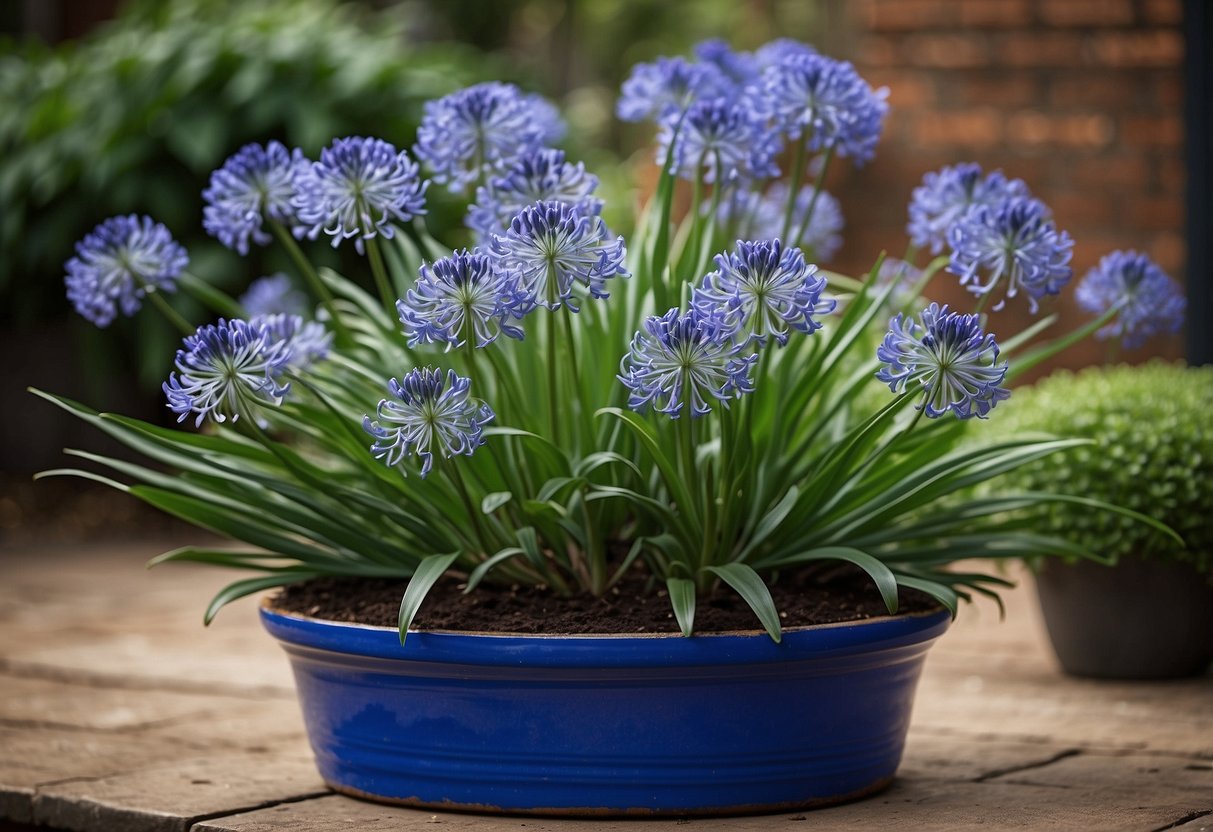
Agapanthus ‘Peter Pan’ is perfect for container gardening.
Its compact size, ranging from 8 to 18 inches tall, makes it ideal for pots. This plant thrives in full sun and well-drained soil.
Place your container in a sunny spot and water regularly. You can enjoy the lovely summer blooms indoors by cutting the long stems at an angle and placing them in a vase.
8) Pair Agapanthus with Ornamental Grasses

Agapanthus pairs beautifully with ornamental grasses. Combining these plants can create a stunning visual effect in your garden.
Consider using Carex testacea. This grass adds a soft texture and a lovely, cascading form. Its year-round appeal makes it a perfect companion for Agapanthus.
Feather reed grass is another great option. It adds height and movement, enhancing the overall look. The tall, slender spikes complement the bold blooms of Agapanthus.
By mixing these plants, you can achieve a striking and dynamic garden display.
For more ideas, visit Gardenia.
9) Agapanthus ‘Queen Anne’ as a Focal Plant

Agapanthus ‘Queen Anne’ is perfect if you want a showy plant to be the centerpiece of your garden. Its tall, upright stalks topped with dense, blue-violet flower clusters draw the eye.
This plant grows to about 24 inches tall with the flowers, making it great for adding height and color. It does best in full sun to partial shade and can even rebloom if you remove spent flowers promptly.
Adding this plant can create a stunning focal point that also brings a touch of elegance to your garden space. Consider using it along pathways, in borders, or as an accent in mixed beds.
10) Create a Tropical Look with Agapanthus ‘Purple Delight’

You can use Agapanthus ‘Purple Delight’ to give your garden a tropical vibe. These plants have dark purple flowers that burst open in the summer, adding a lush, exotic touch.
Place them in a sunny spot and mix them with other tropical-looking plants like banana trees or canna lilies for added effect.
Highlight their beauty by planting them in clusters along garden paths or in colorful pots. This way, ‘Purple Delight’ will truly stand out and make your garden feel like a tropical paradise.
What Is Agapanthus?

Agapanthus, also known as Lily of the Nile, is a popular plant known for its beautiful clusters of blue or white flowers. It thrives in a variety of garden settings and is favored by gardeners for its striking appearance and ease of care.
Common Varieties
Agapanthus comes in several varieties with different colors and sizes. Agapanthus africanus and Agapanthus praecox are two prevalent types.
Agapanthus africanus generally has dark blue flowers and heights ranging from 18 to 24 inches. It’s easy to recognize by its strap-shaped leaves.
Agapanthus praecox, on the other hand, can grow up to 3 feet tall and produces light blue or white flowers.
There are also dwarf varieties like Agapanthus ‘Peter Pan’, which are perfect for smaller gardens or containers. This variety features compact growth and vibrant blue blooms.
Some varieties have flowers with multiple shades. These include Agapanthus ‘Queen Mum’, which displays white petals with a blue base.
Growing Conditions
For best results, plant Agapanthus in areas with full sun. These plants need at least 6 hours of sunlight each day to thrive.
In hotter climates, some afternoon shade can be beneficial. They prefer well-draining soil that’s rich and moist. Adding organic compost can improve soil quality.
Agapanthus is cold-hardy in USDA zones 8-11. In zone 7, it might need extra protection or be grown in containers. During the growing season, regular watering is important, but avoid waterlogged soil. Overwatering can harm the plant.
In summary, selecting the right variety and ensuring proper growing conditions will help you enjoy the full beauty of Agapanthus in your garden.
Designing Your Agapanthus Garden
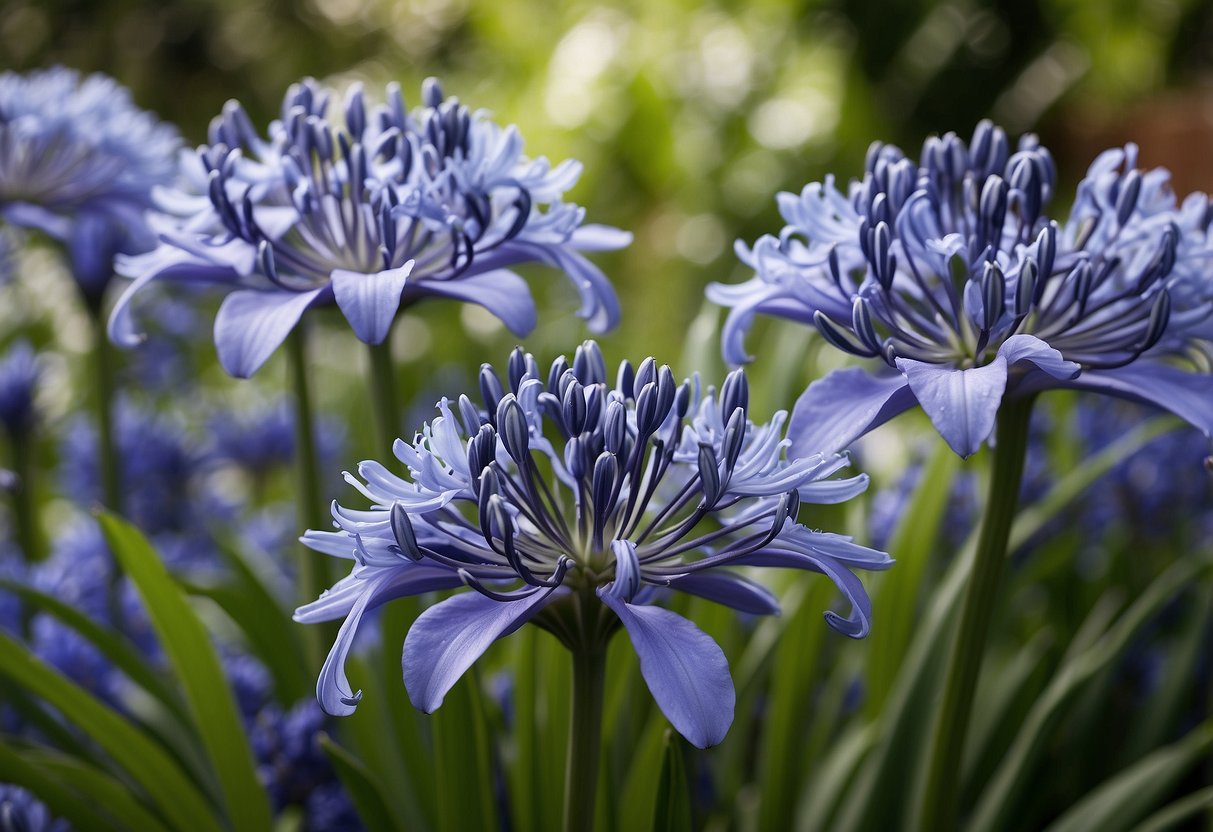
Agapanthus can add color and structure to your garden. With the right color combinations and companion plants, you can create a stunning landscape that is both vibrant and inviting.
Color Combinations
Agapanthus come in various colors, including white, blue, and purple. You can create striking looks by pairing these colors with other plants. For instance, white-flowering agapanthus can brighten up a garden when mixed with darker plants.
Blue agapanthus looks great with yellow or orange flowers for a bold contrast. Purple varieties pair well with silver foliage plants.
Consider the colors of nearby structures or garden décor when choosing your agapanthus to create a cohesive look.
Planting Companions
Agapanthus thrive in full sun and well-drained soil, making them ideal companions for similar plants. You can pair them with plants like lavender, which has silvery-green foliage and fragrant flowers that contrast well with agapanthus blooms.
Other good companions include boxwoods and tufts of ornamental grasses. These plants can help fill in gaps and create a layered effect in your garden.
Tall flower stems of agapanthus work well in the mid or back layer of borders, creating depth alongside lower-growing plants like hostas or ground covers at the front. Shrubs or trees can be placed behind them to add height and dimension.
Experiment with different combinations to see what works best for your garden’s layout and style, ensuring each plant gets the space and conditions it needs to thrive.
For more ideas on agapanthus combinations, you can refer to this guide on beautiful agapanthus landscaping ideas.
Care and Maintenance

Taking care of your agapanthus plants isn’t too hard. Just make sure they get the right amount of water and nutrients.
Watering Needs
Agapanthus plants need regular watering, especially when they are first getting established. Water them deeply once a week, making sure the soil stays moist but not soaked. In hotter regions, some afternoon shade can help them thrive and reduce the need for extra watering.
Tip: During the summer, check the soil regularly and water more often if it starts to dry out. Consistent watering is key during their growing season, but make sure the soil has good drainage to prevent root rot.
Fertilization Tips
Agapanthus are heavy feeders, so they benefit from regular fertilization. Use a balanced fertilizer in the spring as new growth begins.
Tip: Adding organic compost to the soil when planting can give them a great start. Every month during the growing season, apply a water-soluble fertilizer to keep them healthy and blooming.
In colder climates, you might want to reduce feeding towards the end of summer to allow the plants to prepare for winter dormancy. Avoid over-fertilization, as it can lead to lush foliage with fewer flowers.







